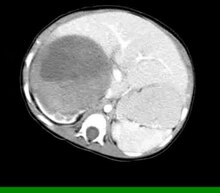Nephroblastoma
| Classification according to ICD-10 | |
|---|---|
| C64 | Malignant neoplasm of the kidney, excluding the renal pelvis |
| ICD-10 online (WHO version 2019) | |
The nephroblastoma (also Wilms tumor , according to Max Wilms , German surgeon, 1867-1918) is the most common malignant kidney tumor in childhood. He starts from embryonic tissue remnants of the kidney, the so-called metanephrogenic blastema . Normally this tissue disappears by the 36th week of pregnancy at the latest.
Epidemiology
The frequency peak is between the ages of two and three and affects one in 10,000 live-born children. Bilateral occurrence is observed in 5% of cases and can be attributed to a familial tumor disease . The genetics of familial nephroblastomas is not yet fully understood. Among other things, the Wilms tumor gene WT-1 on chromosome 11p13 , which plays an important role in the physiological development of the kidneys and probably also the heart, and WT-2 on 11p15 and the Wnt signaling pathway are important .
In the context of syndromes
In some syndromes there is an increased incidence of nephroblastomas, e.g. B. in Perlman syndrome .
Symptoms
The clinical symptoms are mostly non-specific: there is often a painless increase in the circumference of the abdomen, abdominal pain and a palpable mass of the upper abdomen also occur (visceromegaly, enlargement of organs). Anomalies associated with nephroblastoma are also aniridia (hypoplasia of the iris), hemihypertrophy (enlargement of one half of the body) and urogenital malformations. Bloody urine ( hematuria ) is only observed in 5–10% of cases.
Histopathology
As a rule, nephroblastomas consist of soft tumor tissue, which by the time it is discovered can weigh between 500 grams and one kilogram. It is not uncommon for the tumor to grow in the shape of a cone within the renal veins. Metastases are mainly found in the regional lymph nodes and in the lungs. Under the microscope there are small blast cells with a small amount of cytoplasm . However, epithelial and stromal differentiations can also occur.
therapy
The therapy consists of a combined surgical removal of the tumor, chemotherapy and radiation. The exact treatment regimen depends on the tumor stage ( staging ) and tumor histology ( grading ). The German Cancer Society and the German Society for Pediatric Oncology and Hematology publish guidelines for current diagnostic and therapeutic measures in accordance with the generally recognized state of science.
forecast
The prognosis of the disease is good if therapy is in line with guidelines. It depends on the stage of the disease and the histological subtyping; 90% of patients are cured in the long term.
|
CT scan of 11 cm Wilms' tumor , right kidney, 13 month old patient.
|
See also
- Nephroblastomatosis , a precancerous condition from which a nephroblastoma can develop in 50%.
Individual evidence
- ^ M. Wilms: The mixed tumors. Leipzig 1899.
- ↑ MS Kim, SK Yoon, F. Bollig, J. Kitagaki, W. Hur, NJ Whye, YP Wu, MN Rivera, JY Park, HS Kim, K. Malik, DW Bell, C. Englert, AO Perantoni, SB Lee : A novel Wilms tumor 1 (WT1) target gene negatively regulates the WNT signaling pathway. In: J Biol Chem . 2010 May 7; 285 (19), pp. 14585-14593. doi: 10.1074 / jbc.M109.094334 . Epub 2010 Mar 10.
- ↑ P. Reimer, PM Parizel, F.-A. Stichnoth (Editor): Clinical MR Imaging. A practical approach. Springer, 2nd edition 2006, ISBN 3-540-31530-6 , p. 542
literature
- Guideline nephroblastoma (Wilms tumor) of the German Society for Pediatric Oncology and Hematology. In: AWMF online (as of 01/2008)
- Jeffrey S. Dome, Vicki Huff: Wilms Tumor Overview. GeneReviews, University of Washington, Seattle 2006.
- ML Metzger, JS Dome: Current therapy for Wilms' tumor. In: Oncologist . 2005 Nov-Dec; 10 (10), pp. 815-826. Review. PMID 16314292
- Cours d'embryologie en ligne à l'usage des étudiants et étudiantes en médecine - Développé par les Universités de Friborg, Lausanne et Berne (Suisse) sous l'égide du Campus Virtuel Suisse: 20.3 The upper urinary tract: development of the metanephros . Ureteric bud and metanephrogenic blastema : reciprocal induction

